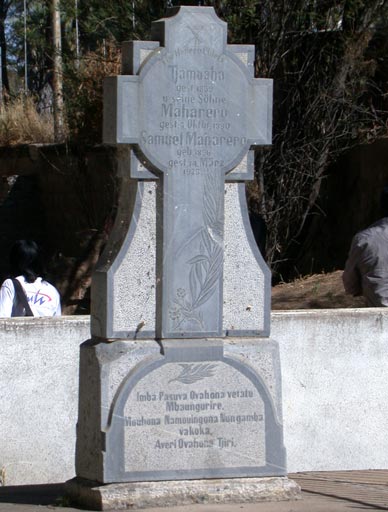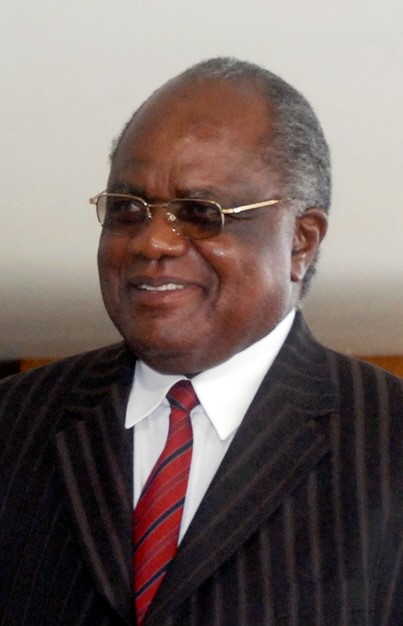|
Helmut Angula
Helmut Pau Kangulohi Angula (born 11 November 1945) is a Namibian businessman, politician, former cabinet minister and writer. He is currently the director of various private companies, after leaving government in 2010, and a longtime member of the central committee and the politburo of the ruling SWAPO party. Biography Angula was born in Ontananga, Oshikoto Region, and joined SWAPO in 1963, just three years after the movement's founding. Angula holds a M.Sc Degree from Voronezh State University in the USSR. During his time with SWAPO, Angula served as the deputy principal of the Health and Education Center in Nyango, Zambia from 1975–1976 and then rose to director of the center until 1977. From 1977- 1986 he was SWAPO chief representative to Cuba, the Caribbean and Latin America, and from 1986 to 1989 served as the SWAPO permanent observer at the United Nations in New York, and as the chief representative to North America. He was elected to the National Assembly of Namibia ... [...More Info...] [...Related Items...] OR: [Wikipedia] [Google] [Baidu] |
The Honourable
''The Honourable'' (British English) or ''The Honorable'' (American English; American and British English spelling differences#-our, -or, see spelling differences) (abbreviation: ''Hon.'', ''Hon'ble'', or variations) is an honorific Style (manner of address), style that is used as a prefix before the names or titles of certain people, usually with official governmental or diplomatic positions. Use by governments International diplomacy In international diplomatic relations, representatives of foreign states are often styled as ''The Honourable''. Deputy chiefs of mission, , consuls-general and consuls are always given the style. All heads of consular posts, whether they are honorary or career postholders, are accorded the style according to the State Department of the United States. However, the style ''Excellency'' instead of ''The Honourable'' is used for ambassadors and high commissioners. Africa The Congo In the Democratic Republic of the Congo, the prefix 'Honourable' o ... [...More Info...] [...Related Items...] OR: [Wikipedia] [Google] [Baidu] |
Voronezh State University
Voronezh State University is one of the main universities in Central Russia, located in the city of Voronezh. The university was established in 1918 by professors evacuated from the University of Tartu in Estonia. The university has 18 faculties and an enrollment of 22,000 students from Russia, Europe, Africa, the Americas and Asia. Besides, the university has 6 research institutes and 16 research laboratories administered by the Russian Academy of Science. The university is composed of 10 buildings and 7 resident halls situated throughout the city. For over 90 years the University has trained more than 100,000 professionals. History In 1802 following a decree of Russian Emperor Alexander I the University of Tartu in Estonia was re-established. As a result of the German occupation of Estonia during World War I in March 1918, Russian students and professors had to leave the Estonian territory for their own safety. It was decided that a new university would be established in centra ... [...More Info...] [...Related Items...] OR: [Wikipedia] [Google] [Baidu] |
New Era (Namibia)
The ''New Era'' is a daily national newspaper owned by the government of Namibia. The newspaper is one of four daily national newspapers in the country, the others being '' The Namibian'' (English and Oshiwambo), '' Die Republikein'' (Afrikaans) and '' Allgemeine Zeitung'' ( German). ''New Era'' was created by the ''New Era Publications Corporation Act of 1992''. According to Ullamaija Kivikuru, it copied the format of ''The Namibian'' in order to establish credibility. The two newspapers still resemble each other in having long stories spread over several pages. ''New Era'' has a usual circulation of 9,000, going up to 11,000 on Fridays.Rothe, ''Media System and News Selections in Namibia'', p. 23. It was established as a weekly newspaper and was later published only bi-weekly. It has appeared daily since 2004. ''New Era'' is published in English and five indigenous languages: Otjiherero, Oshiwambo, Damara/Nama, Silozi, and Khwedam. ''New Era'' is published by the New Era ... [...More Info...] [...Related Items...] OR: [Wikipedia] [Google] [Baidu] |
Orders, Decorations, And Medals Of Namibia
The Republic of Namibia has an honours system comprising orders, medals, military decorations, and police decorations. Legislation also provides for the establishment of decorations and medals for the intelligence service, Namibia Central Intelligence Service Regulations (''Government Gazette'' 1876 (5 June 1998)) the prisons service, Regulations for the Administration and Control of the Namibian Prisons Service (''Government Gazette'' 2643 (8 November 2001)) and the fire services. Local Authorities Fire Brig ... [...More Info...] [...Related Items...] OR: [Wikipedia] [Google] [Baidu] |
Heroes' Day (Namibia)
Heroes' Day is a national public holiday in Namibia. It is recognized by the United Nations as Namibia Day. Celebrated annually on 26 August, the day commemorates the Namibian War of Independence which began on 26 August 1966 at Omugulugwombashe. Origin In 1966 the United Nations General Assembly revoked South Africa's mandate to govern South West African territory and placed it under direct UN administration. South Africa refused to recognize this resolution. South West Africa People's Organization (SWAPO) at that time prepared for armed resistance and founded its armed wing, the People's Liberation Army of Namibia (PLAN) in 1962. Many of its erstwhile commanders were in exile but PLAN began to infiltrate the north of Namibia to establish training camps. Omugulugwombashe was one such training camp, established in June 1966 by PLAN commander John Ya Otto Nankudhu. The group under Nankudhu had just started to build defensive structures [...More Info...] [...Related Items...] OR: [Wikipedia] [Google] [Baidu] |
2009 Namibian Parliamentary Election
General elections were held in Namibia on 27–28 November 2009. They were the fourth general elections since independence and the fifth democratic elections. Voting ended on 28 November and official election results, released on 4 December, showed that Hifikepunye Pohamba and his SWAPO Party were re-elected, each with over 75% of the vote. Prior to the election, the South West Africa People's Organization (SWAPO) was widely expected to score a landslide victory, with the Rally for Democracy and Progress (RDP) considered SWAPO's biggest challenger. Fourteen political parties competed for seats in the National Assembly of Namibia, and twelve candidates ran for the Presidency.Large Victory Likely for Namibia Governing Party New York Times, 28 November 2009 Parties |
National Assembly Of Namibia
The National Assembly is the lower chamber of Namibia's bicameral Parliament. Its laws must be approved by the National Council, the upper house. Since 2014, it has a total of 104 members. 96 members are directly elected through a system of closed list proportional representation and serve five-year terms. Eight additional members are appointed by the President. Since 2015, SWAPO member Peter Katjavivi has been the Speaker of the National Assembly. Namibia's National Assembly emerged on Independence Day on 21 March 1990 from the Constituent Assembly of Namibia, following the elections of November 1989. That election, following guidelines established by the United Nations, included foreign observers in an effort to ensure a free and fair election process. The current National Assembly was formed following elections on 27 November 2019. 2019 elections Previous National Assembly election results Despite being a one party dominant state since its independence in 1990, ... [...More Info...] [...Related Items...] OR: [Wikipedia] [Google] [Baidu] |
United Nations
The United Nations (UN) is an intergovernmental organization whose stated purposes are to maintain international peace and security, develop friendly relations among nations, achieve international cooperation, and be a centre for harmonizing the actions of nations. It is the world's largest and most familiar international organization. The UN is headquartered on international territory in New York City, and has other main offices in Geneva, Nairobi, Vienna, and The Hague (home to the International Court of Justice). The UN was established after World War II with the aim of preventing future world wars, succeeding the League of Nations, which was characterized as ineffective. On 25 April 1945, 50 governments met in San Francisco for a conference and started drafting the UN Charter, which was adopted on 25 June 1945 and took effect on 24 October 1945, when the UN began operations. Pursuant to the Charter, the organization's objectives include maintaining internationa ... [...More Info...] [...Related Items...] OR: [Wikipedia] [Google] [Baidu] |
USSR
The Soviet Union,. officially the Union of Soviet Socialist Republics. (USSR),. was a transcontinental country that spanned much of Eurasia from 1922 to 1991. A flagship communist state, it was nominally a federal union of fifteen national republics; in practice, both its government and its economy were highly centralized until its final years. It was a one-party state governed by the Communist Party of the Soviet Union, with the city of Moscow serving as its capital as well as that of its largest and most populous republic: the Russian SFSR. Other major cities included Leningrad (Russian SFSR), Kiev ( Ukrainian SSR), Minsk ( Byelorussian SSR), Tashkent ( Uzbek SSR), Alma-Ata ( Kazakh SSR), and Novosibirsk (Russian SFSR). It was the largest country in the world, covering over and spanning eleven time zones. The country's roots lay in the October Revolution of 1917, when the Bolsheviks, under the leadership of Vladimir Lenin, overthrew the Russian Provisional G ... [...More Info...] [...Related Items...] OR: [Wikipedia] [Google] [Baidu] |
Oshikoto Region
Oshikoto is one of the fourteen regions of Namibia, named after Lake Otjikoto. Its capital is Omuthiya. The city of Tsumeb, Otjikoto's capital until 2008, and the towns of Omuthiya and Oniipa are also situated in this region. , Oshikoto had 112,170 registered voters. Geography Oshikoto Region is named after Lake Otjikoto near its former capital Tsumeb. Oshikoto is one of only three regions without either a shoreline or a foreign border. It borders the following regions: * Ohangwena - north * Kavango West - east *Otjozondjupa - southeast * Kunene - southwest * Oshana - west Demographics The region's population has grown significantly over recent years, partly as a result of redistribution within the Oshiwambo-speaking area. Apart from Tsumeb and Oniipa, people have settled in a corridor along the trunk road, sometimes forming quite dense concentrations. Economy and infrastructure The northern part of the region is crop agriculture, whereas the main economic activities in ... [...More Info...] [...Related Items...] OR: [Wikipedia] [Google] [Baidu] |
Ontananga
Ontananga is a village in the Oshikoto Region in northern Namibia Namibia (, ), officially the Republic of Namibia, is a country in Southern Africa. Its western border is the Atlantic Ocean. It shares land borders with Zambia and Angola to the north, Botswana to the east and South Africa to the south and e .... It is under the traditional rule of the Ondonga Traditional Authority. References Populated places in Namibia {{Namibia-geo-stub ... [...More Info...] [...Related Items...] OR: [Wikipedia] [Google] [Baidu] |




